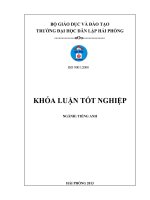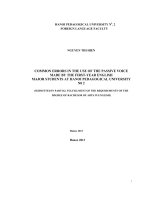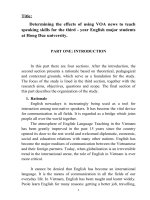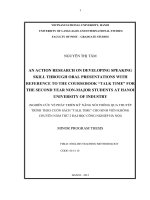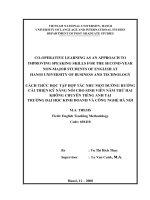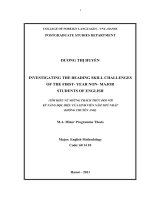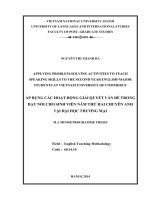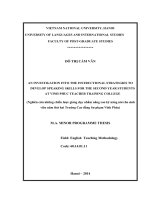using worksheets to develop speaking skill for the first year non major students of hanoi university of industry
Bạn đang xem bản rút gọn của tài liệu. Xem và tải ngay bản đầy đủ của tài liệu tại đây (665.14 KB, 53 trang )
VIETNAM NATIONAL UNIVERSITY, HANOI
UNIVERSITY OF LANGUAGES AND INTERNATIONAL STUDIES
FACULTY OF POST-GRADUATE STUDIES
NGUYỄN VĂN TOÀ N
USING WORKSHEETS TO DEVELOP SPEAKING SKILL
FOR THE FIRST YEAR NON-MAJOR STUDENTS OF
HANOI UNIVERSITY OF INDUSTRY
(Sử du ̣ng bảng biể u nhằ m phát triể n kỹ năng nói cho sinh viên không chuyên năm
thứ nhấ t của Trường Đa ̣i ho ̣c Công nghiêp̣ Hà Nô ̣i)
M.A. Minor Programme Thesis
Field
: English Teaching Methodology
Code
: 60 14 10
Hanoi, 2013
VIETNAM NATIONAL UNIVERSITY, HANOI
UNIVERSITY OF LANGUAGES AND INTERNATIONAL STUDIES
FACULTY OF POST-GRADUATE STUDIES
NGUYỄN VĂN TOÀ N
USING WORKSHEETS TO DEVELOP SPEAKING SKILL
FOR THE FIRST YEAR NON-MAJOR STUDENTS OF
HANOI UNIVERSITY OF INDUSTRY
(Sử du ̣ng bảng biể u nhằ m phát triể n kỹ năng nói cho sinh viên không chuyên năm
thứ nhấ t của Trường Đa ̣i ho ̣c Công nghiêp̣ Hà Nô ̣i)
M.A. Minor Programme Thesis
Field
: English Teaching Methodology
Code
: 60 14 10
Supervisor: Lê Văn Canh, Ph.D
Ha Noi - 2013
iv
TABLE OF CONTENTS
Declaration…………………………………………………………………..i
Acknowledgement…………………………………………………………..ii
Abstract……………………………………………………………………..iii
Table of content…………………………………………………………….iv
List of tables and charts……………………………………………………vii
PART A. INTRODUCTION………………………………………..……..1
1. The rationale of the study...................…………………………….1
2. Purposes of the study..............…………………………………….3
3. Significance of the study................……………………………….4
4. Definitions of terms.............……………………………………….4
5. The design of the study..............…………………………………..5
PART B. DEVELOPMENT………………………………………………..6
CHAPTER 1: LITERATURE REVIEW.............……………………….6
1.1. Definition of speaking skill………………………………………6
1.2. The functions of speaking skill………………………………….7
1. 2.1. Talk as Interaction………………………………………………7
1.2.2. Talk as Transaction………………………………………………7
1.2.3. Talk as Performance…………………………………………….8
1.3. Teaching Speaking……………………………………………..8
1.4. Goals of teaching speaking……………………………………….9
1.5. Principles of teaching speaking…………………………………10
1.6. Developing speaking activities…………………………………..12
1.6.1. Pre-activity stage……………………………………………….12
1.6.2. During activity stage…………………………………………...14
1.6.3. Conclusion stage………………………………………………14
2.1. The concept of worksheets…………………………………….16
v
2.2. The pedagogical significance of worksheets………………....17
2.3. Benefits for students from using worksheet activities………….19
2.4. The teachers’ roles in worksheet activities ……..……………..19
2.5. Preparing a lesson plan for worksheet activities ………………21
CHAPTER 2: THE STUDY………………………………………………25
2.1. The current situationof teaching and learning English at
HaUI……………………...……………………………………25
2.2. Teaching materials……………………..………........... ……….26
2.3. Participants of the study………………………………….......…28
2.4. Research instruments…...………………….......……………….28
2.4.1. Questionnaire……………………………………………………28
2.4.2. The research procedure…………………………..……………29
2.4.3. Follow-up class observation…………………………………..33
CHAPTER 3: RESULTS AND DISCUSSIONS………………………….34
3.1. Results …………………………………………………………...34
3.1.1. Effectiveness of worksheet activities in English speaking
lessons……………………………………………………………34
3.1.2. Students’ attitudes towards applying worksheet activities and
their effectiveness ……………………………………………..…35
3.1.3. Need for worksheet activities……………………………..….35
3.2. Discussions...…………………………………………………….36
PART C. CONCLUSION…...……………………………………………..37
1. Recapitulation………………………………………..…..………..37
2.Conclusions………………………………………..…..…………..38
3. Limitations………………………………………..…..…………..38
4.Suggestions for further studies………….………..…..…………..38
vi
REFERENCES……………………………………………………………..40
APPENDICES
Appendix 1: Student’s questionnaire (in Vietnamese)
Appendix 2: A sample worksheet
Appendix 3: Teacher’s self-reflection (in English)
Appendix 3: Student’s self-reflection (in Vietnamese)
vii
LIST OF TABLES
Table 1:
English curriculum at HaUI
26
Table 2:
Syllabus for teaching the coursebook “New Headway
elementary”
Students‟ attitudes towards worksheet activities
27
Table 3:
34
LIST OF DIAGRAM AND CHARTS
Diagram 1:
Phases of a lesson plan
22
Chart 1:
The effectiveness of worksheet activities in English
speaking lessons
Need for worksheet activities
34
Chart 2:
35
1
PART A. INTRODUCTION
1. The rationales of the study
Language is a means of communication. People can transfer information or
messages and express their ideas and emotions with language. Language is also
used to express everyone‟s hopes, ambitions, and thoughts. Moreover, language
can serve the human needs in their communication in all sectors, such as
industry, military, business, tourism, transportation, sports, international
relations, and especially in education.
Why is it important to develop speaking skill? L2 learners regard speaking as
the most important skill they can acquire, and they (or their friends/family)
assess their progress in terms of their accomplishments in speaking skill.
The fact is that speaking is one of the important and essential skills that needs
a lot of practice to acquire. People who have ability in speaking will receive the
information better. As a matter of fact language is not only taught and learned,
but it is used as a habit. Therefore, students of English must be able to speak
English well because people identify the English mastery with their English
speaking. From the researcher‟s short experience as a teacher, he noticed that
many teachers teach student passively. They speak a lot while their students
listen for most of the time. Students have very little time for practicing this skill.
As a result, the students are not interested in the English learning process. They
become passive in English learning and they are not able to speak.
Speaking is one of the basic skills that require communicative competence,
pronunciation (intonation, stress, and pitch), grammar, vocabulary, fluency,
accuracy, comprehension and gesture improving, in order to build a good
2
communication. These elements are needed to measure the capability of the
students in speaking using appropriate technique. Brown (1994, p. 103) states
that speaking is a skill in producing oral language. It is not only an utterance but
also a tool of communication. It occurs when two or more people interact with
each other aiming at maintaining social relationship between them. According to
Widowson (1994), speaking is the active production skill and use of oral
production. It is the capability of someone to communicate orally with others.
Thus, speaking is an interactive process of constructing meaning that involves
producing, receiving and processing information. By speaking with others, we
are able to know what kinds of situations are there in the world.
English has become a must-have tool for people to pursue personal goals or
studies in Vietnam. Although it has been taught from Elementary School up to
Higher Education, students are lack of capability and self-confidence in
speaking. They often find difficulties in mastering speaking skill. It is widely
recognized that English is really difficult for a lot of students who can use and
understand English language. Therefore, students need more opportunity to
practice English and use it communicatively inside and outside the language
classroom. Florze & Burt (2001) emphasize that "pair and group work activities
can provide learners with opportunity to share information and build a sense of
community". As Cook (1996, p. 90) suggests, such activities “force the students
to use communication strategies whether they want to or not”. Kurt & Akdeniz
(2002) defined that worksheets are materials by which students are given
transaction steps regarding what they are supposed to learn. Also, they include
activities which give the students main responsibility in their own learning.
Worksheet activities involve the learners in getting the information from other
3
partners to complete a given task, gather enough information and report back to
the whole class. Worksheet is the activity, in which the students may be in pairs
or in groups of two or more students. They can be given different pieces of
information about a topic to enable them to complete a task by sharing this
separated information. Worksheet activity is a useful and interesting technique
because it gives every student opportunity to speak, and it reflects the way we
use language as a means of communication in real life. In addition, speaking
with peers is less frightening than presenting alone in front of the whole class
and being evaluated. Teachers only give simple explanation about the activity
and review the vocabulary needed for the activity. Students, on their turn, get an
opportunity to develop their communicative competence more freely.
Demircioğlu (2004) investigated that worksheets are found useful and practical
materials for conceptual understanding if they were effectively used in learning
environments.
From the above knowledge, the researcher is considering that teaching
speaking by using worksheet activities can help overcome these challenges and
weakness of students' speaking ability. Based on this, the researcher would like
to apply the technique into the present classroom by doing a small scale research
on “Using worksheets on developing speaking skill for the first-year non-English
major students at HaUI”.
2. Purposes of the Study
The study aims at achieving the following objectives:
1. Exploring the effectiveness of worksheet activities on developing speaking
skill for the first year non-major students at HaUI.
4
2. In the light of the research results, some recommendations, suggestions and
pedagogical implications will be expounded for both students and learners who
seek to develop speaking skill through using worksheet activities.
3. Significance of the Study
It is hoped that this study will be beneficial for the following reasons:
1- It takes its importance due to the absence of the previous studies which deal
with the use of worksheet activities in teaching speaking skill of English
language at HaUI.
2- It sheds light on the importance of communicative approach, teaching
speaking skill and worksheet activities. This may encourage teachers of English
language to design suitable situational contexts and adapt the implementation of
worksheet in the speaking skill.
3- It can be used to increase the students‟ achievement in English language and
improve their speaking skill.
4- The study will provide data-based evidence of how worksheets can be used in
the speaking lessons to encourage the students to speak English more in the
classroom.
4. Definition of Terms
The researcher includes some definitions of key terms to support the
readers' understanding for this thesis easily. They are as follows:
- Effectiveness: it is the degree of improvement in the students' speaking
skill in English language as a result of using worksheet technique.
- Worksheet: it is where two students or more work together where each
has to make the questions and complete the answers of the other(s). Precisely,
5
worksheet activities are those in which students exchange information in order to
complete a required task.
- Speaking: according to Oxford Advance Learner's Dictionary (1995, p.
827) speaking is making use of words in an ordinary voice; uttering words;
knowing and being able to use a language; expressing oneself in words; making
a speech. In short, the speaking skill is the ability to perform the linguistic
knowledge in the actual communication.
- The first year non-major students: are the students who have just
completed the secondary school and study the first year at Hanoi University of
Industry and English is a basic subject of their course.
5. The Design of the Study
The study consists of 3 parts:
PART A. INTRODUCTION, briefly states the rationales, the purposes, the
significance, the definitions of terms, and finally the design of the study.
PART B. DEVELOPMENT includes 3 chapters
CHAPTER 1: LITERATURE REVIEW includes 2 parts:
Part 1. Reviewing the related literature to speaking skill.
Part 2. Reviewing the related literature and previous studies related to worksheet
activities.
CHAPTER 2: THE STUDY focuses on the subjects, instruments and procedures
of the research methods applied in the study.
CHAPTER 3: RESULTS AND DISCUSSIONS presents study results and
discussion
PART C. CONCLUSION deals with a recapitulation of findings and discussion,
limitations of the study, and the recommendations for further research.
6
PART B. DEVELOPMENT
CHAPTER 1
LITERATURE REVIEW
This chapter reviews the relevant literature to create a theoretical
framework for the study. It first reviews the literature on theoretical issues
related to speaking English as a second or foreign language as well as principles
of teaching speaking skills. Then, it reviews the literature related to the use of
worksheets in speaking lessons.
1.1. Definition of Speaking Skill
Channey (1998, p. 13) stated that "speaking is the process of building and
sharing meaning through the use of verbal and non- verbal symbols in a variety
of contexts". Bryne (1998, p. 8) also said that, "speaking is a two way process
between speaker and listener and involves the productive skill of speaking and
the receptive skill of understanding". In the same respect, Nunan (2003, p. 48)
agrees with Bryne that speaking is the productive oral skill and it consists of
producing systematic verbal utterances to convey meaning. According to
Chastain (1998, pp. 330-358), speaking is a productive skill and it involves many
components. Speaking is more than making the right sounds, choosing the right
words or getting the constructions.
For the purpose of this study, speaking is defined as skills of using English
as a foreign language to communicate orally. The skills involve comprehending,
pronouncing, and being fluent and accurate in using grammar and vocabulary.
7
1.2. The Functions of Speaking
Several language experts have attempted to categorize the functions of
speaking in human interaction. According to Brown and Yule (1991 cited in
Richards, 2007, p. 2), from the functional perspective speaking can be classified
into talk as interaction, talk as transaction, and talk as performance. These are
detailed in the following sections.
1.2.1. Talk as Interaction
The ability to speak in a natural way is required in order to create good
communication. That is why some students sometimes avoid this kind of
situation because they often lose words and feel difficulty in presenting a good
image of themselves. Therefore, language instructors should provide learners
with opportunities for meaningful communicative behavior about relevant topics
by using learner- learner interaction as the key to teaching language for
communication. Since "communication derives essentially from interaction"
(Rivers, 2000, p. 543). Consequently, the giving and taking exchanges of
information will enable them to create discourse that conveys their intentions in
real- life communication.
1.2.2. Talk as Transaction
This type of speaking refers to situations where the focus is on what is said
or done. Burns (1998) as quoted in (ibid, 2007, p. 3) distinguishes talk as
transaction into two different types. One is a situation where the focus is on
giving and receiving information and where the participations focus primarily on
what is said or achieved. The second type is transactions which focus on
obtaining goods or services, such as checking into a hotel. In this type of spoken
language, students and teachers usually focus on meaning. So it is very important
8
for students to obtain those two kinds of talks to master speaking ability, as
Donald (2005) suggests, students need to be competent at both „messageoriented‟ or transactional language and interactional language, language for
maintaining social relationships.
1.2.3. Talk as Performance
This refers to public speaking. It is the talk which transmits information
before an audience such as morning talk, public announcements, and speeches.
Talk as performance tends to be in the form of monologue rather than dialogue
such as giving a class report about a school trip, conducting a class debate, and
giving a lecture. So, talk as performance needs to be prepared in the form of a
written text (Richards, 2007, p.6). Consequently, it is very important when
teachers teach English take care in applying these functions.
In brief, the teaching of speaking skill need to emphasize all these three
functions of speaking.
1. 3. Teaching Speaking Skills
Because any language course should be aimed at enabling the students to
communicate in English, speaking skill needs the special treatment. In reality, in
daily life most of time people speak more than write; yet many English teachers
still spend the majority of class time on reading and writing practice almost
ignoring speaking and listening skills. Based on the statement above, there
should be a good balance to practice in classroom. Therefore, some researchers
and experts have tried to assign the notion of teaching speaking like Nunan
(2003, p. 48) who has clarified it as to teach English language learners to:
- produce the English speech sounds and sound patterns;
9
- use words and sentence stress, intonation patterns and the rhythm of the
second language;
- select appropriate words and sentences according to the proper social
settings situation and subject matter;
- organize their thoughts in a meaningful and logical sequence;
- use language as a means of expressing values and judgments, and
- use the language quickly and confidently.
Teaching speaking, in the researcher's opinion, is the way for students to
express their emotions, communicative needs, interact with other persons in any
situation, and influence the others. For this reason, in teaching speaking skill it is
necessary to have clear understanding involved in speech and also encourage the
potential of the learners to develop their speaking skill naturally. Overall,
teaching speaking skill emphasizes on the activities to make the students active
and creative.
1.4. Goals of Teaching Speaking
As regards speaking is a crucial part of foreign language learning and
teaching. Despite its importance, for many years, teaching speaking has been
undervalued and English language teachers have continued to teach speaking just
as a repetition of drills or memorization of dialogues. However, today's world
requires that the goal of teaching speaking should improve students'
communicative skills. Because only in that way, students can express themselves
and learn how to follow the social and cultural rules appropriately in each
communicative circumstances. Nunan (1998, p.39) sees “mastering the art of
speaking” as the most important aspect of learning a language. While, Ur (1996,
p. 56) said that the most important reason for teaching speaking is to develop
10
oral fluency that is the ability to express oneself intelligibly, reasonably,
accurately and without undue hesitation. According to Harmer (1990) the aim of
teaching speaking is to train students for communication. Add to, Mabrouk
(2003, p. 23) supported that by saying, "students should be able to make
themselves understood, using their current proficiency to the fullest".
Furthermore, Lawtie (2004, p. 35) asserted that "the success of learning language
is measured in terms of the ability to carry out a conversation in the target
language". While, Mashharawi (2006, p. 4) noted that "speaking is fundamental
to human communication. If the goal of teaching language is to enable students
to communicate in English, then speaking skill should be taught and practiced in
the language classroom". Abu Sharbain (2009, p. 23) added that "the
communicative approach calls for increasing the students' talking time and
decreasing the teacher's talking time. This comes as a result of providing the
learners with opportunities to speak through cooperative independent activities".
Based on the previous explanation, the researcher concludes that the goal of
teaching speaking skill is a communicative efficiency i.e. students should try to
avoid confusion in the message due to faulty of pronounciation, grammar or
vocabulary, and to observe the social and cultural rules that apply in each
communicative situation.
1.5. Principles of Teaching Speaking
To achieve the previous goals, teachers should follow certain principles
for teaching speaking, which may help them in designing the classroom activities
and management. Nunan (2003) and Kayi (2006) suggest some principles that
help in teaching speaking:
11
1. The teachers should be aware of the difference between second and foreign
language.
2. The teachers should give students chance to practice with fluency and
accuracy.
3. The teachers should provide opportunity for students to talk by using groupwork and pairwork and limit the teachers' talk.
4. The teachers should plan speaking task to involve negotiation of meaning.
5. The teachers should design classroom activities that involve guidance and
practice in both transactional and interactional speaking.
6. The teachers should ask eliciting questions such as "What do you mean? How
did you reach that conclusion?" in order to prompt students to speak more.
7. The teachers should provide written feedback like "Your presentation was
really great. It was a good job. I really appreciated your efforts in preparing the
materials and efficient use of your voice."
8. The teachers should not correct students' pronunciation mistakes very often
while they are speaking. Correction should not distract student from his or her
speech.
9. The teachers should involve speaking activities not only in class but also out
of class; contact parents and other people who can help.
10. The teachers should circulate around classroom to ensure that students are on
the right track and see whether they need a help while they work in groups or
pairs.
11. The teachers should reduce teacher speaking time in class while increasing
student speaking time. Step back and observe students.
12
In the light of the principles of teaching speaking as mentioned above, it
could be concluded that English teachers, when teaching young learners, have
constantly to keep in mind the fact that they deal with a mixed class with varied
abilities, expectations, motivation level, knowledge and, last but not least,
different learning styles. Moreover, English teachers should create a classroom
environment where students have real life communication, diagnose problems
faced by students who have difficulties in expressing themselves in the target
language. Therefore, the teachers need to vary their approaches and offer as
much opportunity as possible to make the whole class find a little something to
hold on to expand and grow.
1.6. Developing Speaking Activities
Several methodologists and teaching specialists suggest and describe the
organization of activities focused on the development of speaking skill with
different names and numbers of stages. Three elementary stages have been
suggested: pre-activity stage, during-activity stage, and conclusion stage. For the
purpose of this thesis, the researcher adopted these three stages. Primarily, the
lessons plan in the current study will be based on Harmer‟s (2001) theoretical
inputs related to organizing pairwork and groupwork, which originally and as
suggested, each stage includes certain areas of focus, for which didactic
principles have been collected as a synthesis of several sources.
1.6.1. Pre-Activity Stage
The first stage, pre-activity stage, includes two focus areas: „engageinstruct-initiate sequence‟ and „grouping students‟.
13
Engage, Instruct, Initiate Sequence
Firstly, engagement, according to Harmer (2001, p. 59) means “making it
clear that something „new‟ is going to happen”. As regards giving instructions,
this involves a number of aspects that need to be considered for achieving the
maximal affectivity of activities: Firstly, Ur (1991) and Byrne (1991) assert that
explaining instructions in mother tongue is acceptable especially with classes
whose knowledge of the target language is not on a sufficient level yet.
Secondly, there is a length of instructions. Optimal choice, according to
Scrivener (1994, p.98) that is based on sequencing instructions in a sensible
order, using short sentences and avoiding or separating instructions clearly from
„the other chit-chat, telling off, joking, etc. Furthermore, Gower et al. (1995, p.
41) propose that instructions should be supported with visual clues such: real
objects, pictures, gestures and mime or instructions written on the cards. Thirdly,
as a part of initiation, it is most appropriate to tell students how much time they
have got and exactly when the students should start the activity (Harmer, 2001,
p. 59).
To sum it up, for the „engage-instruct-initiate sequence‟, the researcher
says that it is necessary to activate students by phrases offering a rationale for the
activity together with paying a careful attention to providing instructions with a
final time allocation.
Grouping Students
There are different ways of grouping learners, it means dividing them into
pairs or groups. Harmer (2001, p. 120-122) suggests four basic ways: friendship,
streaming, chance, and changing groups.
14
1.6.2. During Activity Stage
During-activity stage, the focus is on „the roles of the teacher that he or
she can take on during activities‟. Another focus area concentrates on „providing
feedback during activities‟; and, finally, „the mother tongue use‟.
The Role of the Teacher
Byrne (1991, p. 13) divides the roles of the teacher according to the type
of interaction activity distinguishing between fluency and accuracy activities.
During fluency activities the teacher most frequently adopts the roles of
stimulator, manager and consultant. On the other hand, the roles that the teacher
carries out during accuracy activities will primarily include the roles of
conductor, organizer and monitor.
Providing Feedback
According to Richards and Lockhart (1999, p. 188), feedback on students‟
spoken language can be either positive or negative and may serve not only to let
students know how well they have performed but also increase motivation and
build a supportive climate.
1.6.3. Conclusion Stage
This stage will include two focus areas that several methodologists, e.g. Ur
(1991), Harmer (2001), and Gower et al. (1995) comment on when describing
the ending phase of an activity: stopping the activity, and providing feedback
after the activity.
Stopping the Activity
Before the actual process of bringing the activity to the end, however,
some pairs or groups may finish earlier than others. Such extra work may
15
include, for example, a further elaboration of the task, getting students to read
their books, or asking students to get on with their homework (Ur, 1996, p. 22).
The researcher agrees with Ur's advice, in relation to extra activities, that
it is very important to have them ready at hand in order to make students busy
not disturbing others, though, especially for the beginners teachers this might be
sometimes rather time consuming.
Feedback after the Activity
It is necessary to provide a positive feedback that is likely to motivate
students and bring about some kind of improvement, along with pointing out
what went wrong during the activity. Furthermore, it is not important to
concentrate on who made the
mistakes but rather focus on the mistakes that
have been frequent among the students (Harmer, 2001, p. 123). The researcher
asserts that, a language teacher should take into consideration these three
important stages when organizing speaking activities for improving his/her
student's speaking ability.
As discussed in part 1, one of the principal goals of the communicative
approach to language teaching is that the learners are involved in actual
interaction in the classroom. This interaction must be meaningful and involve an
authentic use of language. (Basturkmen, 1994, p.50). To help students develop
their communicative efficiency in speaking, there are some activities used in the
classroom to promote the development of speaking skill in our learners. The
discussions below center on worksheets activities as one of the strategies that the
researcher used to investigate the effectiveness of these activities on developing
speaking skill in the current study.
16
2.1. The concept of Worksheets
Kaymak(2006) claimed that worksheets have been used in educational
activities for a long time and the using of worksheet in educational activities
started after the invention of paper and writing. But, modern worksheets were
started to be used in education with the invention of pen and pencil after the
American Civil War (1861-1865) in order to support teaching and learning
(Harmon & Jones, 2005, p. 160). Worksheets are practical, useful and economic
materials to use in educational activities. Kaymak (2006).
Worksheets derive from the concept of the instructional model. The
instructional model is one of the models of the constructivist learning approach.
it consists of five phases. Relevant literature describes the implementation of
each phase of the instructional model in teaching science concepts given below
(Goldston, Day, Sundberg & Dantzler, 2010; Hanuscin & Lee, 2008; Krantz, &
Barrow, 2006; Krantz, 2004; Liu, Peng, Wu & Lin, 2009; Orgill & Thomas,
2007; ệzsevgeỗ, 2006; Vincent et al., 2008; Wilder & Shuttleworth, 2005):
1- First Phase „Engage‟: It includes attracting students‟ interest to the
concept, revealing students‟ pre-knowledge about the concept and making
students aware of their own knowledge and querying them about the concept. At
this stage, students are not expected to express the correct concept. This stage is
a warm-up phase in which students become ready to learn.
2- Second Phase „Explore‟: Students test their own knowledge by doing
observations and gaining experiences about the concept. They work in groups.
They try to explore scientific knowledge. Teacher directs students to study with
video, computer, and in library environments and students are encouraged to
solve problems.
17
3- Third Phase „Explain‟: This phase is the teachers‟ most active phase
and it includes students sharing and debating their experiences with each other.
Students are encouraged to compare their prior knowledge with observations and
explain the relationship between them. At this stage, teachers could benefit from
using methods such as computer software, flash animations, Conceptual Change
Text (CCT), argumentation, expression, and video.
4- Fourth Phase „Elaborate‟: Students are encouraged to adapt new
knowledge they have acquired in previous phases to different situations and to
associate it with their daily life. Work sheets, model preparation, activities
including drawing, problem situations and questions related to daily life are used
to enhance the relationship between the concept and daily life. Moreover, at this
stage students find answers to the questions which are asked to motivate them at
the “enter” stage.
5- Fifth Phase „Evaluate‟: Students query new knowledge of the concept
they have learned in the previous four stages and make an extraction. And,
eventually, they assess their own improvement.
Instructional materials play an important role in ensuring the effectiveness
of teaching and learning activities. Worksheet is a kind of printed instructional
material that is prepared and frequently used by teachers in order to help students
to gain knowledge, skills and values by providing helpful comments about the
course objectives and enabling students to engage in active learning and
learning-by-doing in and out of the school (Kaymakcı, 2006, p. 5).
2.2. The Pedagogical Significance of Worksheets
Worksheets have been used in educational activities for a long time. It can
be claimed that using of worksheet in educational activities started after the
18
invention of paper and writing. But, modern worksheets were started to be used
in education with the invention of pen and pencil after the American Civil War
(1861-1865) in order to support teaching and learning (Harmon & Jones, 2005,
p. 160).
Worksheets are materials by which students are given transaction steps
regarding what they are supposed to learn. Also, they include activities which
give the students main responsibility in their own learning (Kurt & Akdeniz,
2002). Thus worksheets are known to help students gain scientific process skills
such as setting up experimental mechanism, recording data, interpreting the data,
and so on so that they can conceptualize the concepts in their minds. There are
several studies showing that worksheets increase students‟interest in the lesson
and affect their success in a positive way (Saka & Akdeniz, 2001; Kurt, 2002;
Costu & Ünal, 2005; Özmen & Yildirim, 2005; Kurt & Ayas, 2010).
A worksheet is an instructional material which is suitable with any
learning approaches such as constructivist learning approach, conceptual change
approach etc. When literature is examined, it is seen that different worksheets
have been developed about various science concepts (Çalik, 2006; HavuNuutinen, 2005; Ipek & Çalik, 2008; Karsli & Sahin, 2009; Kurnaz & Çalik,
2008; Moore & Harrison, 2007; Sahin et al., 2009; Sahin, 2010; Türk & Çalik,
2008; Tytler, 1998a; Ürey & Çalik, 2008; Ünal, 2005; Yin, Tomita & Shavelson,
2008). Worksheets can be used for different purposes, such as development of
scientific process skills with laboratory activities (Karsli & Sahin, 2009). Before
the preparation of worksheets, their structure should be determined explicitly.
Pictures, images, cartoons, and interesting daily life questions can be used to
make worksheets interesting and eye-catching.
19
Worksheets have been preferred in educational research for presenting the
activities based on the 5E instructional model in a good sequence. Also, even if
students are highly affected by computer animations, they may lose their
motivation over time. Therefore, worksheets are used to make computer
animations more effective and to provide the continuity of students‟ interest
(Bayrak & Dogan, 2009).
2.3. Benefits for Students from Using Worksheet Activities
Research also suggests that the presence of worksheet activities is
beneficial both in teacher-student exchanges and student-student interaction in
the form of pairwork and groupwork. Kayi (2006) says that in worksheet
activities, students are supposed to be working in pairs or in groups. Each partner
plays an important role because the task cannot be completed if the partners do
not provide the answers to questions the others ask. These activities are effective
because everybody has the opportunity to talk extensively in the target language.
Basturkmen (1994, p. 50) added that, it is not only a more satisfying role for the
learners but also promoting authentic language use in the class. Therefore,
teachers need to actively engage students in speaking activities that are enjoyable
and that are based on a more communicative approach.
2.4. The Teacher's Roles in Worksheet Activities
It has already been cited that the teacher is the most important figure in the
teaching process, and s/he is the first responsible for the actual standard of
teaching English in schools and the level of the students` achievement. The
following points clarify the teacher's role in activating and developing students'
ability as shown by different methodologists:

